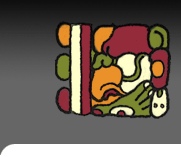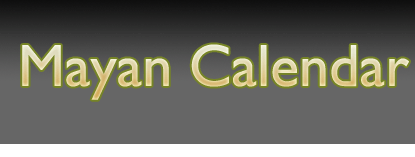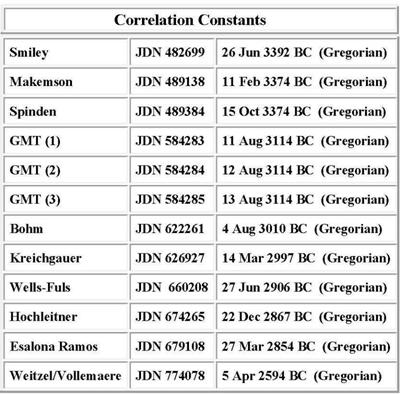 |
 |
 |

| Over the history of ancient Maya studies, a wide variety of Christian calendar correlation dates have been suggested.
Today, the majority of scholars fall into one of two camps - the GMT and the GMT+2. GMT stands for
Goodman-Martinez-Thompson, the three early scholars who compiled the evidence correlating the Julian calendar
(in use during the initial European contact) with the Maya calendar. The GMT+2 has gained popularity because certain carved
monuments with astronomical data, such as the solar eclipse recorded on a stela from Poco Uinic in Chiapas, correlate
better with two days after the original GMT. Of the two options, the modern Maya of Guatemala who still keep the calendar follow the GMT. Out of respect for living tradition, the dates presented here also follow the original GMT.
The two options presented above may be the most widely accepted, but they are far from the only correlations put forward. Here's a list of other correlation options: 
Calendar Correlation Options (chart by Finley 2003) The first mention of the correlation between the Christian and Maya calendars came from Diego de Landa, first Bishop of Yucatan, who wrote about it in his 1566 Relacion de las Cosas en Yucatan. At that time, the Maya had a calendrical cycle they called the u kahlay katunob. Scholars today call it the 'K'atun Wheel". It was a 13 k'atun cycle, which totaled 260 tuns (of 360 days each), or 256 years. Each k'atun was named by the tzolk'in day on which it began. Because the 20 day names of the Tzolk'in are an even divisible of the tun (360 days), a k'atun beginning can only start on an Ahaw day. Thus, the 13 k'atuns of the K'atun Wheel were named 1-13 Ahaw. Landa recorded that the year Merida was established, 1541, was also the first year of K'atun 11 Ahaw. This would give us the impression that the previous k'atun, 13 Ahaw, ended sometime in 1540. Then in another section of his Relacion, he recorded the first day of a Maya year that fell on 12 Kan 1 Pop and tied it to Sunday, July 16. Between these two we can back track and peg K'atun 13 Ahaw's end to a long count of 11.16.0.0.0 13 Ahaw 7 Xul and a Julian Calendar date of Nov 3, 1539. Converting to the Gregorian calendar and counting back to the start of the long count, we arrive at the date August 11, 3114 BC. Now, of course Landa was not aware of the long count calendar, it having fallen out of common use centuries before European contact. However, the dates he recorded ended up being major keys for the Maya scholars of the late 1800's. The first scholar to propose the year 3114 BC was Joseph Goodman, a young American journalist who was Mark Twain's first editor. His work was supported by a Yucatecan scholar named Juan Martinez, who introduced Goodman to the Books of Chilam Balam and the Chronicle of Oxkutzkab, colonial documents written by the Maya themselves which contained dates corroborating the dates in Landa's Relacion. He published a small and little noticed paper on his findings in 1897. Thirty years later, in 1927, eminent Maya scholar J. Eric Thompson revived Goodman's work and collaborated with John Teeple to test it against astronomical data in hieroglyphic texts from the Maya Classic Period. Teeple's focus was the Lunar Series and he was looking for a correlation that would correctly place the new moon cycles he had discovered. Putting it all together in a 1937 land mark publication, Thompson proposed the GMT (Goodman Martinez Thompson) Correlation, also known as the 584283 correlation. The term 584283 correlation comes from the formula Thompson employed to arrive at the date August 11, 3114 BC. The number 584283 is the number of days one has to count from Julian Day Number 0 to arrive at August 11, 3114 BC. The Julian Day Number System, not to be confused with the Julian Calendar, was established by Joseph Justus Scaliger in the 16th Century, specifically to correlate non-western calendar dates. In order to accommodate the most ancient calendars known at that time, he arbitrarily began the JDN count at Greenwich, at 12 o'clock noon, on January 1, 4713 B.C. |


